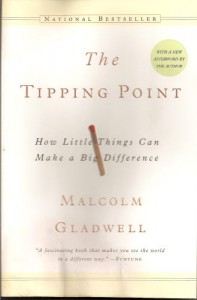 I realized not long ago that it had been a while since I read an actual book. I spend a lot of time at my computer screen and read a ton of websites and blogs, but actual books….not so much. And when I think about it I really miss reading.
I realized not long ago that it had been a while since I read an actual book. I spend a lot of time at my computer screen and read a ton of websites and blogs, but actual books….not so much. And when I think about it I really miss reading.
I used to read all the time. Louis Lamour and other westerns, Clive Cussler and the adventure genre were some of my favorites. For my return to reading I’ve decided to read business and marketing oriented books to increase my knowledge of my chosen area of expertise.
I got the recommendation for my first book from Cory Miller and James Dalman’s Webdesign.com reading list. It’s called The Tipping Point by Malcom Gladwell and I thought I’d share my thoughts on it.
This was my first Malcom Gladwell book and I’m sure it won’t be the last. I like his writing style. The Tipping Point is a book about change and some deep thinking on epidemics. Gladwell himself describes the book as an “intellectual adventure story”. It largely exposes some concepts that you will have to walk around with for a while before the practical use becomes apparent. At least that has been my experience.
From the description of the book I was hoping to get some practical ideas for creating more interest in my business, i.e. to improve my marketing efforts. It’s not that kind of book. I think it just might turn out to be better.
In the book, Gladwell spends a lot of time developing the idea of how epidemics are started and spread and gives specific examples. Some of the examples are about disease epidemics as you might expect but the others are about crime, fashion, bad habits and school shootings. I’ll have to admit that in the middle of some of the lengthy examples he almost lost me. If this happens to you, stick with it. At the end you’ll realize that you need the benefit of the examples in order to apply the principles.
Gladwell’s findings are that almost always, a tiny percentage of the do the majority of the work to start an epidemic. He calls this the Law of the Few. The other two rules of The Tipping Point are The Stickiness Factor and The Power of Context. He uses these three rules to organize thinking about epidemics and help us to understand how to create a Tipping Point of our own.
Carrying out the rules of the Tipping Point are three main types of people. Gladwell calls these Mavens (information brokers and are teachers), Connectors (who know “everybody”) and Salesmen (excellent at influencing people).
Again, examples from various parts of history are given including Paul Revere (a Connector and a Maven). Each of these people play a different but vitally important role in an epidemic.
With my subconscious mind armed with the concepts about how and why epidemics are created and spread I am now watching for that piece of information that will help me answer the question that Gladwell leaves us with in the Afterward of the book. That question is: “How do I find the Mavens that will spread the word about my particular business?” or put differently, how do I build a Maven trap?
The last few pages of the book are the best in my opinion, but would be of much less value without the experience of the examples so again, stick with it. It’s worth it.
In conclusion, I highly recommend The Tipping Point. If you’ve read the book and figured out how to build a Maven trap in your business, I’d love to hear about it. Why not leave a comment?
Leave a Reply
You must be logged in to post a comment.